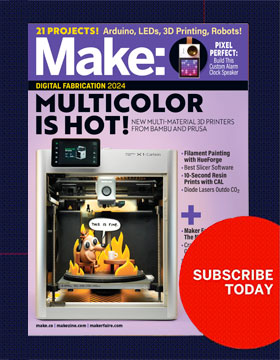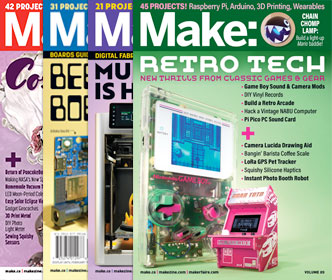
 CNC milling is about as cool as it gets, except for one big problem: the free software options pretty much blow, especially for a CNC noob. The team at Inventables is aiming to fix that with the release of Easel, the first browser-based CNC design/fabrication controller.
CNC milling is about as cool as it gets, except for one big problem: the free software options pretty much blow, especially for a CNC noob. The team at Inventables is aiming to fix that with the release of Easel, the first browser-based CNC design/fabrication controller.
Traditionally, CNC projects are designed in CAD software, then exported as G-code and sent to intricate computer-aided manufacturing (CAM) software setup, where the machining data is created based on desired cut paths, tool speeds, etc. It takes a long, long time to master, and as anyone who’s broken an end mill knows, the learning curve is stressful.
Easel is designed to be the beginner’s gateway tool, aiming to get an aspiring machinist from inception to milling in under five minutes. The app, officially announced and demonstrated at Austin’s ATX Hackerspace for SXSW, lets the user create a design using a number of built-in shapes, an uploaded vector file, or by drawing freehand in the app. The display shows both 2D and 3D versions of your creation on a virtual waste board, and indicates areas that fall off the material as you build your design.
The design portion, reminiscent of Tinkercad in look and simplicity, is a step forward for getting started with CNC, but the captivating part is the CAM aspect, which is automated and invisible when using Inventable’s Shapeoko mills. The software needs just a few pieces of information: material type (which currently includes aluminum, birch, maple, bamboo, walnut, and bubinga), material thickness, cut thickness, and bit size. With that, it’s able to calculate the speed and cut rate based on built-in libraries of information. Plug the Shapeoko into your laptop’s USB port, align your material, and click the start button, and your mill is off to the races.

While this opens up the CNC field to a new range of users, the ease of use still creates a tradeoff in how much control you have. Inventables CEO Zach Kaplan explains that it’s still a beta release with limitations that will be addressed as they move forward. There’s no ability to input specifics about your router bit (like fluting) or create new materials, although you can edit the material properties in the six they use. But bigger than that, it’s currently only able to cut on one plane, meaning it works great for cutting out shapes or making engravings. If you want to do 3D contours, you’re stuck with old-fashioned CAD/CAM setups, for now — this is also on Kaplan’s list of future functions.
If you’re not a Shapeoko owner, it’s still possible to use the software and export the G-code to your CAM setup. The app can’t control other machines via USB for the same “just hit cut” simplicity, but with its beta status, it will be interesting to see how it grows from here.

Engraving wood on the Shapeoko with Easel software at ATX Hackerspace.

Digital Fabber’s CNC Jamboree recently held its second annual event in Long Lake Park in Lakeville, Ohio last month. It looked like a really cool event with demonstrations of CNC machines, classes on CBC best practices, and a show and tell of projects. ShopBot (also a Maker Faire sponsor) was a major participant with representatives from the company demonstrating a number of different techniques throughout the weekend.
Digital Fabber is a site that serves as a clearinghouse for CNC router projects. It’s an online magazine, with project plans downloadable for a fee. It looks like it hasn’t been open for very long and there are only a few articles so far, but it has a lot of promise. If you’re looking for more opportunities to share your work and learn about others’ projects, be sure to check out next year’s jamboree.
The TinyG is an embedded, multi-axis motion control system from Synthetos designed for CNC applications that require highly precise motion control for small to medium sized motors. The TinyG has been used with the Shapeoko and a previous version of the board was used as the basis for the Othermill electronics.
World Maker Faire TinyG Demos
TinyG Pendulum Demo
Synthetos recently released a new V8 version of the TinyG, which uses constant jerk acceleration planning for very smooth and fast motion transitions for any type of machine (as can be clearly seen from the videos). They showed off their hardware with three fantastic motion control demos at World Maker Faire.
TinyG Ping Pong Ball Drawbot Demo
TinyG Hammer Swinging Demo
Why It’s Awesome
Here are just a few features of the new TinyG v8 hardware, which sells for $129.99 and is available from the Synthetos webstore:
- Constant jerk acceleration planning (3rd order S curves) for smooth and fast motion transitions (as can be clearly seen from the videos).
- Microstepping up to 1/8 (optimized DDA makes this smoother than many 1/16 implementations)
- 6-axis control (XYZ + ABC rotary axes) maps to any 4 motors
- Very smooth step pulse generation using phase-optimized fractional-step DDA running at 50 Khz with very low jitter
- Integrated motion control system with embedded microcontroller (Atmel ATxmega192)
- 4 stepper motor drivers (TI DRV8818) integrated on a ~4 inch square board
- Stepper drivers handle 2.5 amps per winding which will handle most motors up thru NEMA23 and some NEMA34 motors
- Accepts Gcode from USB port and interprets it locally on the board
- Networkable via SPI to support off-board devices and for networking multiple boards into multi-axis systems
[Features quoted from the TinyG section of the Synthetos site.]

Jaws drop when makers see a five-axis CNC at work. That’s what happened to me when I saw PocketNC performing its magic. I peered closely and saw a spindle moving along two axes milling a piece of plastic mounted on a trunnion moving along/around three axes. The result of a three-year, four-prototype development effort of husband and wife team Matt and Michelle Hertel, PocketNC is getting ready for market.
Machinists and mechanical engineers, this couple loves building things. After participating in many Instructables contests and putting in up to 30 hours per week on their entries, they eventually decided to channel their energies into something which they could sell as a product. Matt had wanted a mini mill but couldn’t find what he wanted at the price he was willing to pay. Over the course of their research, they found that many others wanted the same thing so they decided to build their own but jumped straight to five-axes.
While their prototyping efforts started in the house they quickly converted a 10×10 shed to a workshop where they worked. From the start, the mill’s frame was built of aluminum but they are always working to reduce weight, presently at 25 pounds. The mill uses stepper motors and they can cut dependably to a tolerance of +/- 1/5000th of an inch, the spindle turns at 500-6000 rpm for plenty of range for speeds and feeds of various materials. The millable volume is 5″ diameter by 4″ tall. This gem can mill plastic and aluminum and they’re confirming that it can also mill steel and titanium
World Maker Faire was their first big public showing of PocketNC and they found it invigorating. After years spent working on the project in isolation it was exciting to see so many positive reactions from the maker community. They’ve come a long way after multiple prototypes. They still want to test more materials, switch their controller to Synthetos, and then go to market but with measured organic growth till they get it totally right.
Cost? They’re shooting for around $3,000.
‘Maker Names (not publicly visible) Fabrizio D’Eramo
‘Maker Names (not publicly visible) Steampunk 99 ETS
‘Maker Names (not publicly visible) luca cortelli
‘Maker Names (not publicly visible) Team Maker Nexus
‘Maker Names (not publicly visible) Bay Area Robotic Combat
‘Maker Names (not publicly visible) Ahona Chatterjee

 CNC milling is about as cool as it gets, except for one big problem: the free software options pretty much blow, especially for a CNC noob. The team at Inventables is aiming to fix that with the release of Easel, the first browser-based CNC design/fabrication controller.
CNC milling is about as cool as it gets, except for one big problem: the free software options pretty much blow, especially for a CNC noob. The team at Inventables is aiming to fix that with the release of Easel, the first browser-based CNC design/fabrication controller.






